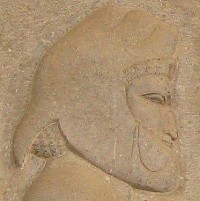Sagartians
Q2211728Sagartians (Old Persian Asagarta): a nomadic tribe in ancient Persia, probably living in the neighborhood of modern Yazd.

Probably the oldest piece of information about the Sagartians is contained in a brief catalogue that found its way into the Histories of the Greek researcher Herodotus of Halicarnassus (fifth century BCE). He tells us that in the days of the Persian king Cyrus the Great (559-530)
the Persian nation contained a number of tribes [...]: the Pasargadae, Maraphii, and Maspii, upon which all the other tribes are dependent. Of these, the Pasargadae are the most distinguished; they contain the clan of the Achaemenids from which spring the Perseid kings. Other tribes are the Panthialaei, Derusiaei, Germanii, all of which are attached to the soil, the remainder - the Dai, Mardi, Dropici, Sagarti, being nomadic.note
These tribes joined Cyrus when he subjected a rival tribal coalition, the Medes, in 550. For a generation, the Sagartians were loyal subjects, but after the death of Cyrus' son and successor Cambyses (522), they revolted against the Achaemenid empire under their leader Tritantaechmes. However, they were pacified by Takhmaspâda, a general sent out by the new king of Persia, Darius I the Great. Tritantaechmes was crucified in Arbela.
When Darius organized his kingdom, he first accepted the Sagartians as a single unit: an inscription on the Persepolis terrace, which can be dated in c.515, places them on the same rank as the other satrapies. However, they were later put in the same tax district as the Drangians, Thamanaeans, Utians and the people who had been deported to the Persian Gulf. From this, we can deduce that they must have lived somewhere east or northeast of the Persians, and the oasis of Yazd is a good guess. When king Xerxes invaded Greece in 480, the Sagartians belonged to the same contingent as the Drangians, Utians and the deported ones. Herodotus mentions that they were conspicuous for their brightly colored clothes and high boots reaching to the knee.note
After this expedition, they disappear from history. The historians who describe the campaign of the Macedonian king Alexander the Great in Persia, do not mention them. (Local traditions from Yazd maintain that he used the oasis to keep people in detention.) However, the Greek topographer Ptolemy makes a mention of a pass through the Zagros Mountains which was in his age, the second century CE, still called the "Sagartian gate". Indeed, the nomadic Sagartians may have occasionally have reached the Zagros.